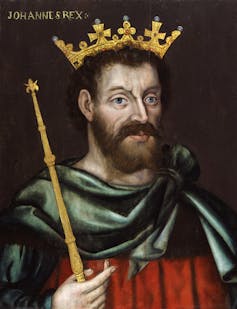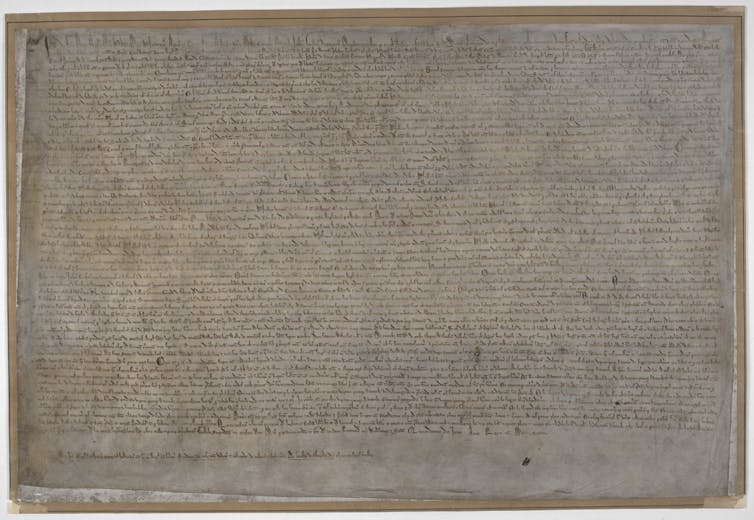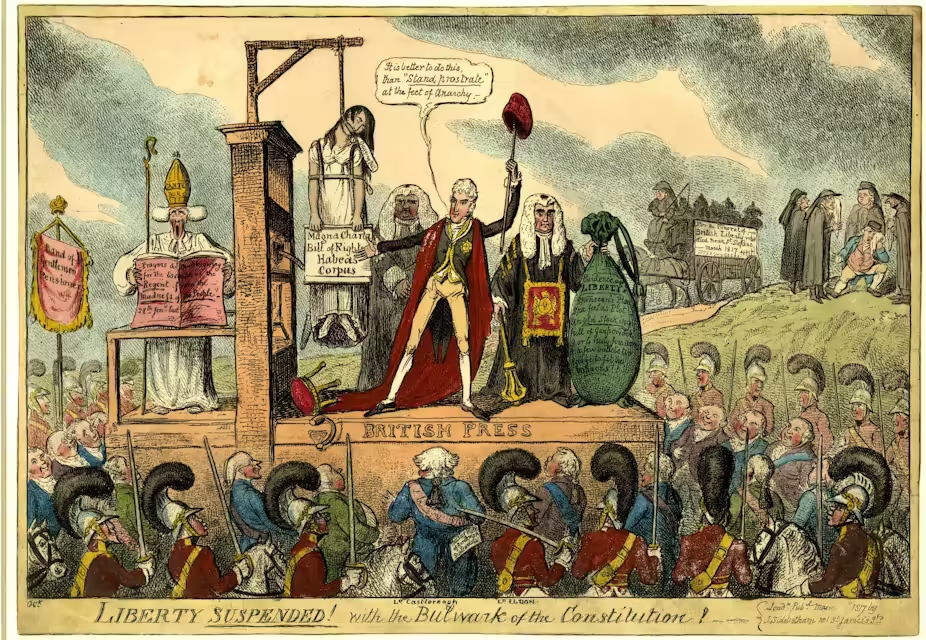Reading time: 5 minutes
Eight hundred years after King John made history when he fixed his seal to the Magna Carta, the public is being re-introduced to one of the most famous documents in political history.
For two days in February, for the first time ever, the four surviving copies were briefly assembled in the same place at the same time – and the British Library’s major new exhibition Magna Carta: Law, Liberty, Legacy has just opened to the public.
By Julian Harrison, British Library
But as one of the exhibition’s curators, I’ve been steeped in all things Magna Carta for the past four years, choosing the exhibits, negotiating the loans, writing the catalogue and the labels. Curating this exhibition on the 800-year history of one of the world’s most famous documents has enabled me to explore new topics and epochs and to encounter numerous fascinating insights into the story of Magna Carta.
Many visitors to the exhibition will doubtless have their heads turned by the American Declaration of Independence (written by Thomas Jefferson himself) or the United States Bill of Rights, neither of which have visited Britain before. Others may be more intrigued by King John’s teeth, removed from his tomb at Worcester Cathedral in 1797, which we have on display alongside part of the king’s shroud and a fragment of his leather shoe.

But it’s the lesser-known stories that have particularly intrigued me as I’ve collected any and all references to this most revolutionary of documents.
Would you have thought, for example, that this 1215 document was still being called upon at the time of World War II? By the British Union of Fascists (BUF)? No, I didn’t either. In 1939, the British government had introduced Defence Regulation 18B, which provided that persons deemed to be a threat to national security could be detained indefinitely. Among those imprisoned were Oswald Mosley, leader of the BUF, and his wife, Diana, one of the storied Mitford sisters.

Diana Mosley’s mother, Lady Redesdale, wrote a letter of protest to Lord Cranborne, secretary of state for dominion affairs, in which she stated that Defence Regulation 18B had “broken the Constitution” and “broken Magna Carta” by taking away an Englishman’s right to trial. Of course, in Cranborne’s opinion, releasing Diana and Oswald Mosley was out of the question, and they remained in prison until 1943.
Something else that particularly catches my attention is a fascist pamphlet dating from the same period, entitled Magna Carta in the Dustbin, published at Half Moon Cottage, Little Bookham, by Count Potocki, the self-styled King of Poland.
Built-in obsolescence
Another less well-known fact is how little of Magna Carta remains valid today, at least in UK law. Magna Carta is sometimes cited in court cases, but more often as a rhetorical flourish. The vast majority of its provisions were repealed by parliament from 1828 onwards.
Only three clauses of the original Magna Carta remain on the statute book, namely those protecting the liberties of the English Church and the liberties of the city of London and other towns, ports and boroughs. But, of course, there’s also the most famous clause of all, which effectively states that:
No man can be arrested or imprisoned save by the lawful judgement of their equals or by the law of the land. To no one shall we sell, deny or delay right or justice.

The reason that so much of Magna Carta has been repealed is that much of it related to obsolete medieval customs such as forestry and fishing rights, and of course many of what – at the time – were ground-breaking legal rights have since been overtaken by more modern legislation. This might come as a shock to those correspondents who frequently contact the British Library seeking to discover if Magna Carta can be used to overturn parking tickets issued in the city of Westminster. The answer, somewhat unsurprisingly, is that Magna Carta, despite its symbolic status in English and global legal history, does not have magic powers to secure the waiver of such fines.
So the Magna Carta, as well as having a long and prestigious history, has also been invoked in some very strange situations. Above all, what this shows is the overwhelming symbolic status that this document drawn up by medieval barons has garnered. Despite being 800 years old, many people over the ages have seen it as the source of their freedom from everything, whether that be death or a parking ticket.
This artcle was originally published in The Conversation.
Podcasts about Magna Carta
Articles you may also like

“Vinegar Joe” Stilwell: the Story of America’s Man on the Ground in WW2 China
Reading time: 12 minutes
As famed as American commanders like Dwight Eisenhower and Douglas MacArthur are today, one of the most important is the relatively little-known Joseph Stilwell.
He was one of its leading experts on a country that was to play a pivotal role in the history not just of the war, but of the 20th century: China.

General History Quiz 50
The History Guild Weekly History Quiz.See how your history knowledge stacks up. Have an idea for a question? Submit it here and we’ll include it in a future quiz! Please leave this field emptyTell me about New Quizzes and Articles Get your weekly fill of History Articles and Quizzes We won’t share your contact details […]

Australian VC’s in the Mediterranean, WWII – Video
There were six Australian VC recipients during the Mediterranean and North African Campaigns of the second world war. From the heroics of Lt. Roden Cutler in Damour, Corporal Edmondson of the Desert Rats defending Tobruk in 1941 to Sgt. Kibby with his tommy-gun in El Alamein. Learn more about Australian gallantry in the Deserts of North Africa.
The text of this article is republished from The Conversation in accordance with their republishing policy and is licenced under a Creative Commons — Attribution/No derivatives license.








